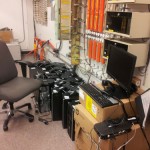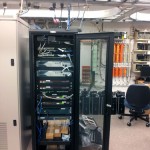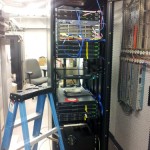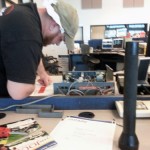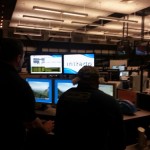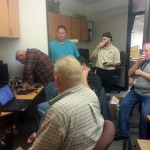My team, Technical Services at Valley Emergency Communications Center has spent much of the last year researching, funding, planning, installing and implementing a revolutionary IP based 9-1-1 call delivery system in Utah. Our idea was so revolutionary and groundbreaking as well as being so cost effective that several other agencies asked to join in our system with many others planning on joining in the near future.
9-1-1 call centers need to start rolling out NG 911 or Next Generation 911 by early next year as mandated by the Federal Government. NG-9-1-1 is designed to handle text to 911 as well as video or pictures. These features are currently not active with our new system so don’t try texting 911 just yet. The new phone system gives us the flexibility to offer those services in the very near future.
The new phone system was a third the price of a typical 9-1-1 call delivery system saving potentially millions of dollars in 9-1-1 funds.
The install was accomplished over a 48 hour period. We divided our land lines and cell lines between the two system and brought up one position at a time. It was a monstrous project completed with co-operation and hard work from VECC IT staff , VECC operations , Intrado, Vectra Solutions, and Alpine Geographic.
We were also featured in a story on KSL-5 TV
The article below was featured in 9-1-1 Magazine.
Agencies, vendors deliver the state’s first emergency services Internet protocol network (ESInet) for 9-1-1 calls
9-1-1 call centers serving Salt Lake, Davis, Weber and Morgan counties have taken the initiative to provide the first Internet protocol (IP)-capable 9-1-1 call delivery system in Utah. Salt Lake Valley Emergency Communications Center (VECC) Executive Director, William Harry, State of Utah Department of Public Safety (DPS)/Salt Lake Communications Center (SLCC) Dispatch Center Manager, Chris Rueckert and Weber Area Dispatch 9-1-1 and Emergency Services District (Weber) Executive Director, Tina Scarlet, have led this collaboration of six individual public safety agencies to provide multiple levels of 9-1-1 network survivability—ultimately improving public safety for approximately 1.6 million citizens.
In November 2011, the team came together to submit a request for information for an IP-based, multi-node, 9-1-1 call-handling solution. They wanted to implement a “shared model” as many of the various public safety answering points’ (PSAPs) call-processing equipment (CPE) was approaching end of life and would no longer be supported. The project, “The Greater Wasatch Multi-Node Project,” was established to find an IP-delivery system that would provide multiple levels of redundancy, advanced call-routing capabilities, greater efficiencies and ultimately less cost than their various on-premises solutions.
The plan for the Greater Wasatch Multi-Node Project was to use the VECC and Weber 9-1-1 centers to host the CPE and call-taking applications, providing access to other PSAPs via the ESInet. This plan would allow PSAPs to pool their resources by sharing costs for two centers instead of spending funds on CPE and applications for multiple centers.
When the collaborating entities compared their current vendor’s solution to alternatives offered by Intrado and CenturyLink, they decided that the Intrado and CenturyLink platform had the IP capabilities that best met their expectations. Intrado and CenturyLink offered an emergency service number (ESN)-based ESInet for all 9-1-1 wireline and wireless call handling and routing; IP-based Intrado VIPER® call processing equipment that provided quadruple redundancy at VECC and Weber; and a common database for call routing and mapping systems that display caller location.
Once the team made their decision, the Utah 9-1-1 Committee funded most of the project with grants.
In January of 2013, VECC, Weber Area 9-1-1, and DPS/SLCC went live on the new ESInet, surpassing expectations as the first IP-capable 9-1-1 network for the state of Utah. As a result, the Greater Wasatch Multi-Node Program has provided immediate financial benefits. “This new shared model has already provided substantial savings on both CPE and call-trunking costs,” explained Rueckert.
As an added feature, the solution also provides “agent roaming.” In other words, the new platform can leverage advanced call-routing technology to share call-taking positions from call takers across different PSAPs during times of high-call volume. “A 9-1-1 call taker or dispatcher can log into any shared workstation, at any location, and receive and dispatch emergency calls as if they were at their own PSAP,” said Scarlet. “This collaboration of individual PSAPs and sharing of resources is unprecedented in Utah.”
“The sharing of resources is a new frontier for all of us,” said Rueckert. “All too often, we see other state governments mandate that PSAPs collaborate and create a consolidated solution. We took this initiative on ourselves, because it was the right thing to do.”
Other PSAPs across the state are lining up to benefit from this new shared-network solution. The Bountiful City Police Department, Greater Salt Lake Unified Police Department and the Salt Lake City Police Department are just a few agencies that will be joining the Greater Wasatch Multi-Node Program in the very near future. “The new ESInet platform started as a beta test for NextGen 9-1-1 and now it’s become the standard for new deployments,” said Harry.
Lastly, the IP capability of the ESInet has set the foundation for other NextGen 9-1-1 data services and applications, such as text-to-9-1-1 and media as they become more readily available. “We are confident that the benefits of this new technology will improve public safety in the near future,” acknowledged Harry.
For more information on VECC, see http://vecc9-1-1.com/
– Corporate News/9-1-1magazine.com (via Intrado, 3/20/13)



